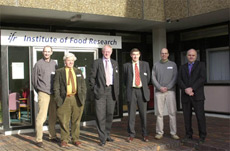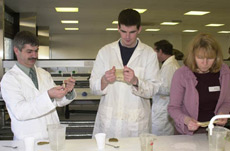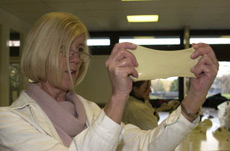

 'Science behind Agriculture' speakers and organisers.
Left to right Phil Smith (TSN), Martin Wolfe, Ben Gill, Phil Russell, Ian Foot & Dave Hart (IFR/TSN)
'Science behind Agriculture' speakers and organisers.
Left to right Phil Smith (TSN), Martin Wolfe, Ben Gill, Phil Russell, Ian Foot & Dave Hart (IFR/TSN)
Science often throws up contrasting views of the world, each viewpoint being staunchly defended by their supporters. A provacative programme of talks at this Master Class ensured lively debate throughout.
The day began with a lively presentation exploring the benefits of organic farming under the title 'the need for a more ecologically integrated agriculture.' Prof. Martin Wolfe reported first hand experiences of organic arable farming which has taken his research on varietal mixtures a step or two beyond the glasshouse trials into full blown field trials and highlighted their benefits to insect and bird populations. As an alternative to fertiliser, swards of clover are sown as natural soil enrichment utilising the nitrogen-fixing abilities of the legume root symbionts, Rhizobium spp.
In contrast, our second talk looked in detail at the process involved in the development of a fungicide 'from concept to market.' Prof. Phil Russell has held senior positions with many of the large agrochemical companies and took the audience on a multi-million pound journey from the screening of a potential 'new' compound to a new product rigorously tested for formulation, efficacy and environmetal impact. Approximately 1 million new compounds are screened every year, in the hope of producing 2 new products. Such mass screening has necesitated miniaturisation of the screening process often using robotics and with the high costs and risks involved the emphasis is on products that are suitable for mass markets - widely grown or high-cost crops eg. wheat, rice and vines. Phil also talked about some of the major chemical groups that have dominated the fungicide world, durable or short-term in their success and highlighted similarities and differences in terms of modes of action between the major chemical groups.
After coffee, it was the turn of a local plant breeder, Mr Ian Foot who works for Nickerson (UK) Ltd. to talk about the selection of wheat varieties that are most suitable for bread-making. Bread-making requires a flour with specific properties of elasticity and extensibility and these properties are determined by the dough-forming proteins, the gliadins and glutenins which can be screened for with biochemical and genetic tests. The quantity and quality of these proteins is genetically determined and plant breeders can take up to 7 years to produce a new variety of wheat with modified (improved?) flour. Such properties are also controlled by the environment the wheat is grown within and so understanding the quality requirements for a 21st century baker is quite a challenge.
In the last days of his presidency of the National Farmers Union it was a great pleasure to introduce our final speaker, Sir Ben Gill. He was able to talk about first-hand experiences of how scientific developments within agriculture have affected his life as a Yorkshire farmer and how the farmers own local knowledge is one that cannot be replaced be technology. Understanding your own climate, crops and livestock is the 'magic' element that complements the technological developments which have, over the years, bought vaccination programmes, more efficient mechanisation and improved animal husbandry and more resistant crops . Sir Ben has also held many roles within the research councils and his talk 'Farmer and Science - muck and magic' rounded-off perfectly a stimulating set of talks.


The afternoon practical acivities gave our teachers the chance to explore the bread-making protein gluten, looking at the elasticity and extensibility of different doughs from different flours (above). The technology behind protein electrophoresis was also demonstrated. This was followed by a microscope session examining some of the crop diseases that are usually controlled by extensive fungicide applications. Particular thanks to Ian Foot and Phil Russell for staying to run these sessions and to Liz Sayers (JIC) for the electrophoresis.